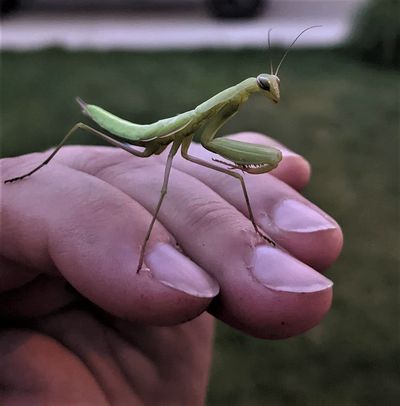Bugging the Northwest: Praying Mantis is martial artist (and Martian) of the insect world

Seeing a praying mantis up close is like encountering a Martian. With its lime-green color, bulging eyes and a triangular-shaped head that swivels atop a long neck, it has an extraterrestrial appearance.
The species that appears in this column’s photograph is a European mantis, or Mantis religiosa, said entomologist Michael Bush of the Washington State Department of Agriculture in Yakima.
You might not have noticed these beguiling green creatures earlier this summer because they were young, small and fairly dull-colored. No more. “Adult mantises, because of their size and activity, are most noticeable in August and September,” he said.
Although European mantises don’t eat plants, they have voracious appetites, devouring everything from aphids and mosquitoes to grasshoppers, crickets, bees and cockroaches. Sometimes they eat each other.
“Generally speaking, the European mantis is considered a beneficial insect, despite the fact that it is not native to Pacific Northwest, let alone North America,” said Bush. Nonetheless, it is now the most common species in our region, he said.
As the insect’s common name suggests, it was introduced to the U.S. from Europe. They were first documented in New York state in 1900 to help control grasshopper infestations, according to the “National Audubon Society Field Guide to North American Insects and Spiders.”
The “religiosa” part of this species’ name refers to the way they position their two front legs at an angle as if folded in prayer. But in no way are they displaying an act of reverence. Instead, they’re poised, Zen-like, to ambush prey for their next meal.
Studies show that they often wait in grasses or flowers for an unsuspecting insect to draw near. Then the mantis leaps and lands as swiftly and precisely as a cat. Next, using those “praying” forelegs armed with spikes, they snatch and hold the prey for consumption.
Besides being formidable ambush killers, European mantids can also be cold-hearted kin and lovers.
Sometimes “they will eat their siblings that emerge from the same ootheca,” or capsule of eggs, Bush said. “And yes, sometimes the adult female will eat the male after copulation,” he added.
If you can look past their terroristic hunting and eating practices and appreciate their endearing looks and ability to keep pest numbers down, there are ways to attract them to your garden.
“One of the best ways to encourage mantids in the home landscape is to provide plenty of tall grass, shrubs and green plants for them to hide in,” said Bush, “and to refrain from using broad-spectrum insecticides.”